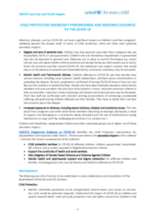Infectious diseases, such as COVID-19, can have a significant impact on children’s and their caregivers’ wellbeing beyond the disease itself. In terms of child protection, there are three main potential secondary impacts:
- Neglect and lack of parental care. Children may lose parental care when their caregivers die, are hospitalized, fall ill, or are quarantined. Children who are themselves hospitalized or quarantined may also be deprived of parental care. Measures put in place to control the disease e.g. school closure, may also leave children without parental care during the day (as their parents are at work). Given the concerns and fear around COVID-19, the traditional care support systems that would step in in the absence of parental care (extended family, community members) may be disrupted.
- Mental health and Psychosocial distress. Children affected by COVID-19 and their families face various stressors including social isolation, health related fears, and fears about contamination or spreading the disease. Persons suspected or confirmed of having COVID-19 have to face not only fear but also isolation in medical facilities. People who have been medically cleared as well as family members and care providers may also face social isolation, rumors, exclusion and even violence in their communities. Important rituals of grieving such funeral and burial practices may be disrupted. Front line staff are confronted with stressful working environments of witnessing considerable suffering and grief among children affected and their families. They have to battle their own fear and concerns about the disease.
- Increased exposure to violence, including sexual violence, physical and emotional abuse. This may result from caregivers and other adult family members becoming increasingly distressed, a sense of support and belonging to a community being disrupted and the use of dysfunctional coping mechanisms to cope with the challenging environment (i.e. alcohol, etc.).
Children with disabilities, marginalized children and other vulnerable groups are at higher risk of these secondary impacts.
This guide from UNICEF East Asia and Pacific Region provides guidance on preparing for, and responding to child protection needs during the COVID-19 crisis.

